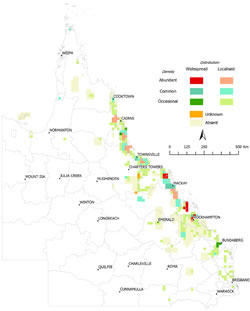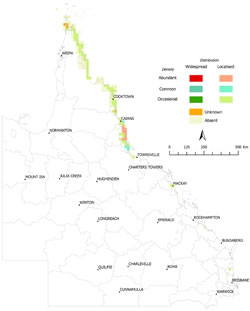
Invasive non-native freshwater flora species
You are viewing an archived copy of the 2017 report.
Key finding
Invasive non-native flora species can have significant impacts on freshwater ecosystems including smothering native vegetation, blocking creeks, reducing water quality by preventing light penetration, reducing oxygenation of water, and choking out fish and other aquatic wildlife.
Invasive non-native flora species — aquatic weeds — can:
- form thick weed mats on water surfaces, preventing light penetration to submerged aquatic plants causing their death
- block creeks, restricting water flow and reducing fish activity due to submerged weed masses. These submerged weeds can choke out fish and other aquatic wildlife
- reduce water quality by preventing light penetration, trapping silt and reducing oxygenation of water, making waterbodies unsuitable for some native fish species
- invade and degrade natural wetlands by outcompeting and smothering native vegetation
- lead to increased flooding — for example, Hymenachne can do this by reducing the flow capacity of drainage networks.
A number of aquatic weeds are established in Queensland. These pest plants are distributed predominantly along the east coast. Established pest plants in freshwater wetlands include:
- alligator weed
- Senegal tea plant
- Hygrophila
- pond apple
- cabomba
- water hyacinth
- Hymenachne
- water lettuce
- Salvinia.
Pond apple can remain viable and germinate in estuarine environments: there is potential for this weed to spread downstream of current infestation sites.
More information:
Indicator: Invasive non-native flora species identified in freshwater wetlands
A selection of distributions of invasive non-native wetland flora species from the Australian Pest Species Distribution Survey database. Data is current, ranging from 2012–2014.
 Distribution of Hymenachne (Hymenachne amplexicaulis), 2011–2012. Source: Australian Pest Species Distribution Survey
Distribution of Hymenachne (Hymenachne amplexicaulis), 2011–2012. Source: Australian Pest Species Distribution Survey Distribution of pond apple (Annona glabra), 2011–2012. Source: Australian Pest Species Distribution Survey
Distribution of pond apple (Annona glabra), 2011–2012. Source: Australian Pest Species Distribution Survey

